How to Start Meal Planning: Transform Your Kitchen Routine
Master how to start meal planning with our proven system. Save time, boost nutrition, and reduce food waste with expert strategies designed for your real life.
Ready to Simplify Your Meal Planning?
Get personalized meal plans and grocery lists automatically matched to your macro targets.
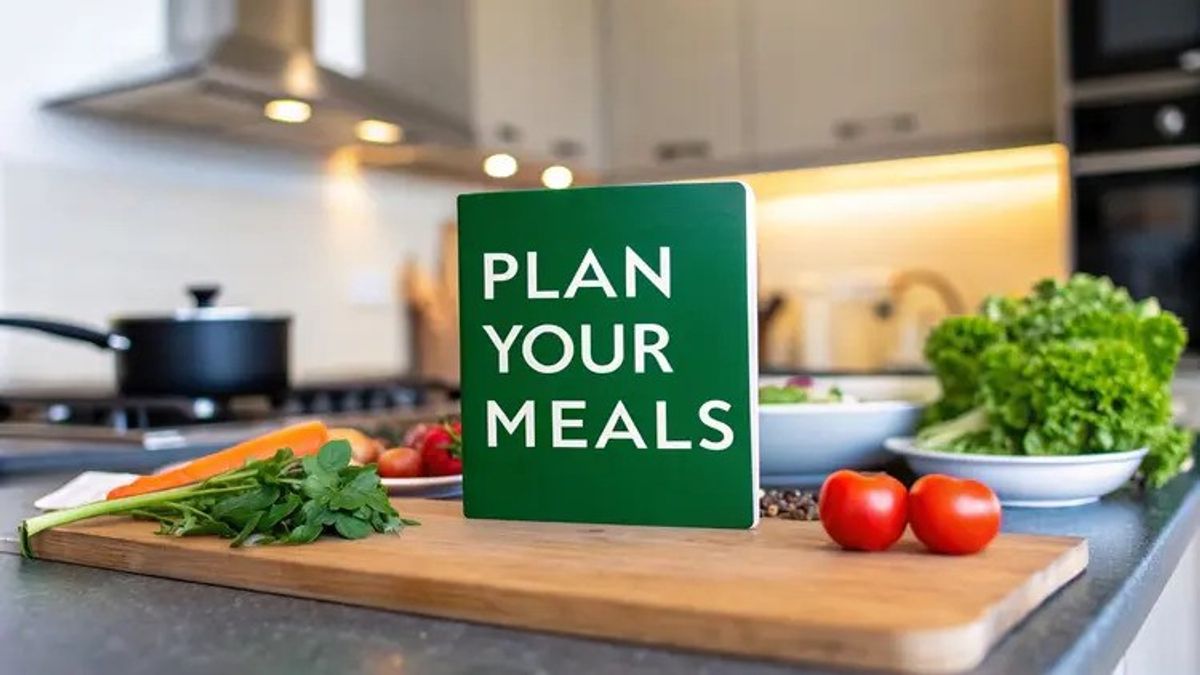
How to Start Meal Planning: Transform Your Kitchen Routine
Why Meal Planning Changes Everything: Beyond Time Savings
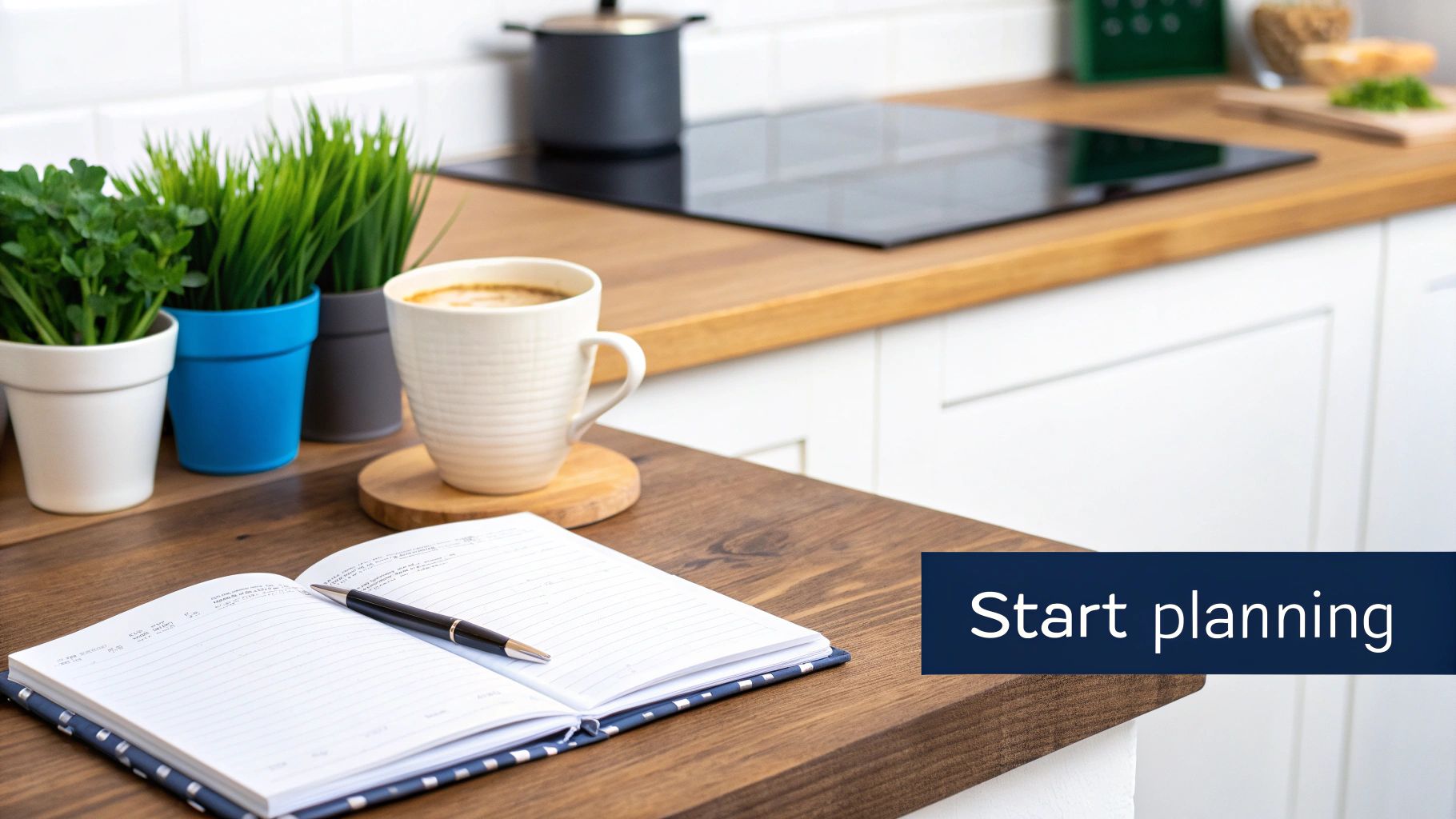
Sure, saving time is great. But meal planning offers so much more than just a few extra minutes in your day. It's about building a healthier, happier, and less stressful relationship with food. This has a domino effect, impacting your wallet, your well-being, and even your family dinners. Let's dive into how meal planning can seriously upgrade your life.
Healthier Eating Habits: Fueling Your Body Right
One of the biggest wins with meal planning? It's a direct path to better nutrition. When you plan ahead, you're way more likely to pick nutrient-rich foods and mix up your ingredients. This conscious decision to put nutrition first sets the stage for better overall health.
Starting a meal planning routine can significantly impact your eating habits for the better. Studies show that meal planners tend to have better diets with more variety. Check out this research for more details. This is a big deal these days, considering how little time people spend cooking. For example, in the US, cooking time dropped from 1 hour and 38 minutes daily in 1965-1966 to just 58 minutes by 2006-2007. That's where those handy meal planning apps come in. Over 23 million people in countries like the U.S., Canada, India, and Australia use recipe and cooking apps. These apps not only save time but also offer a wider range of recipes and meal schedules to help you stay balanced.
Taming Decision Fatigue: Freeing Up Mental Space
Beyond the nutritional perks, meal planning offers a hidden benefit: reducing decision fatigue. Think about all the food choices you make in a day – breakfast, lunch, dinner, snacks. It’s exhausting! But with a meal plan, those decisions are already made.
That mental freedom lets you focus on more important things, leaving you less stressed and more present. Imagine having the mental energy to really connect with your family or crush it at work, all because you know exactly what's for dinner.
A Healthier Relationship with Food: Long-Term Impact
For many, meal planning becomes more than just a practical tool; it's a way to build a better relationship with food. By being mindful of your food choices, you start to understand your nutritional needs and what you genuinely enjoy eating.
This mindful approach can lead to more satisfying meals and a more balanced perspective on food. It’s about ditching impulsive choices for a sustainable, nourishing connection with what you eat. Meal planning can be a game-changer for long-term dietary improvements, way beyond just saving time. It's an investment in your overall well-being.
The Meal Planner's Toolkit: What Actually Works
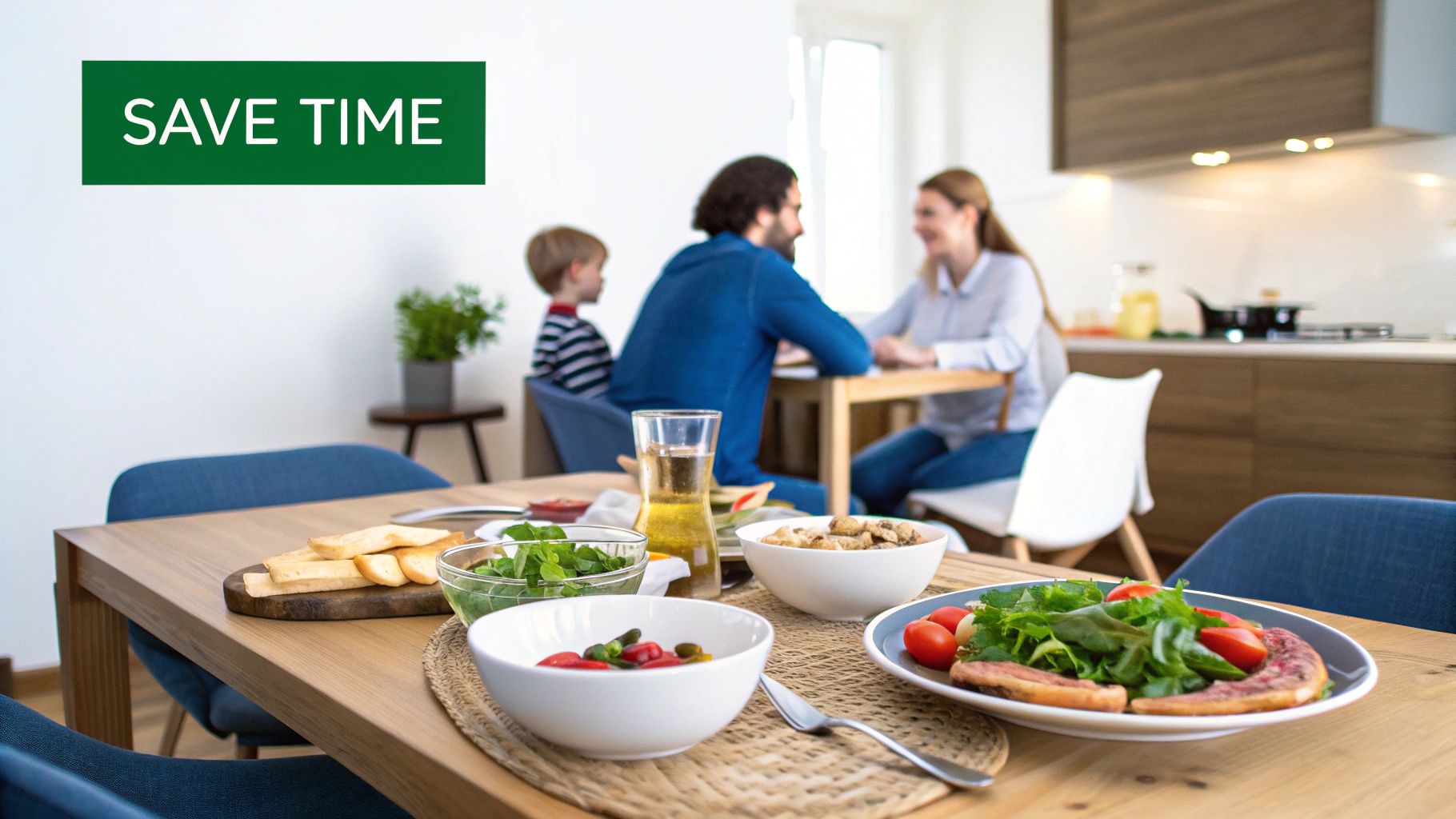
Tired of chaotic mealtimes? Want to ditch the last-minute scramble and actually enjoy cooking again? The secret lies in having the right meal planning tools. Forget fancy gadgets and complicated software—it's about finding what truly simplifies your life and fits your unique cooking style.
Digital Tools: Tech-Savvy Meal Planning
Today's digital world offers a plethora of meal planning options, ranging from simple recipe storage to AI-powered personalization. Apps like Meal Flow AI can learn your preferences and even generate shopping lists for easy grocery delivery. These smart tools take the guesswork out of planning, saving you precious time and energy.
Many apps also offer nutritional tracking and dietary customization. Meal Flow AI even integrates with Instacart, automating everything from meal creation to ingredient delivery. Now that's what we call convenient!
Analog Methods: The Charm of Pen and Paper
But digital isn't the only game in town. Many people find solace and clarity in the tangible act of writing. A simple notebook can transform into a powerful meal planning hub, holding all your recipes, weekly schedules, and culinary inspirations. This analog approach can be particularly helpful for visual learners.
Physical templates and planners also offer a customizable way to track family preferences, dietary needs, and budget goals. For some, this tactile experience can be even more enjoyable than navigating digital interfaces. Remember, the best tool is the one you'll actually use.
Combining the Best of Both Worlds: A Hybrid Approach
Why choose when you can have both? Mix and match digital and analog tools to create a system that truly works for you. Use an app like Paprika Recipe Manager for recipe discovery, then jot your weekly meal plan on a physical whiteboard for easy family visibility. This hybrid strategy offers ultimate flexibility.
Let's talk numbers. The global meal planning and recipe app market is exploding. In 2023, it was valued at $496.77 million, and it's projected to reach a staggering $1,186.19 million by 2030. The meal planning app market itself, valued at $95.52 million in 2023, is expected to hit $223.48 million by 2031, showing a 12.91% CAGR. This impressive growth is driven by AI advancements and personalized features catering to diverse lifestyles. Want to learn more? Dive into the details here.
To help you choose the perfect planning method, check out this helpful comparison:
Meal Planning Tools Comparison
A comprehensive comparison of digital and traditional meal planning tools to help you choose the right option for your needs.
| Tool Type | Best For | Average Cost | Time Investment | Key Features |
| Digital Apps (e.g., Meal Flow AI, Paprika) | Tech-savvy users, busy individuals, specific dietary needs | $0-$10/month | Low to Moderate | Recipe storage, AI-powered meal planning, grocery lists, nutritional tracking, integration with delivery services |
| Analog Methods (e.g., notebook, planner) | Visual learners, budget-conscious individuals, hands-on planning | $5-$20 (one-time purchase) | Moderate | Customizable planning, visual overview, tactile experience |
| Hybrid Approach | Flexible planning, combining digital and analog benefits | Varies | Moderate | Personalized system, adaptable to individual needs |
As you can see, each method offers unique advantages. Digital tools offer automation and convenience, while analog methods provide a tactile and personalized experience. The hybrid approach combines the best of both.
The key takeaway? The best meal planning toolkit is the one that seamlessly integrates into your routine and makes planning feel less like a chore and more like a step toward a more enjoyable culinary life.
Building Your First Meal Plan: A Practical Framework
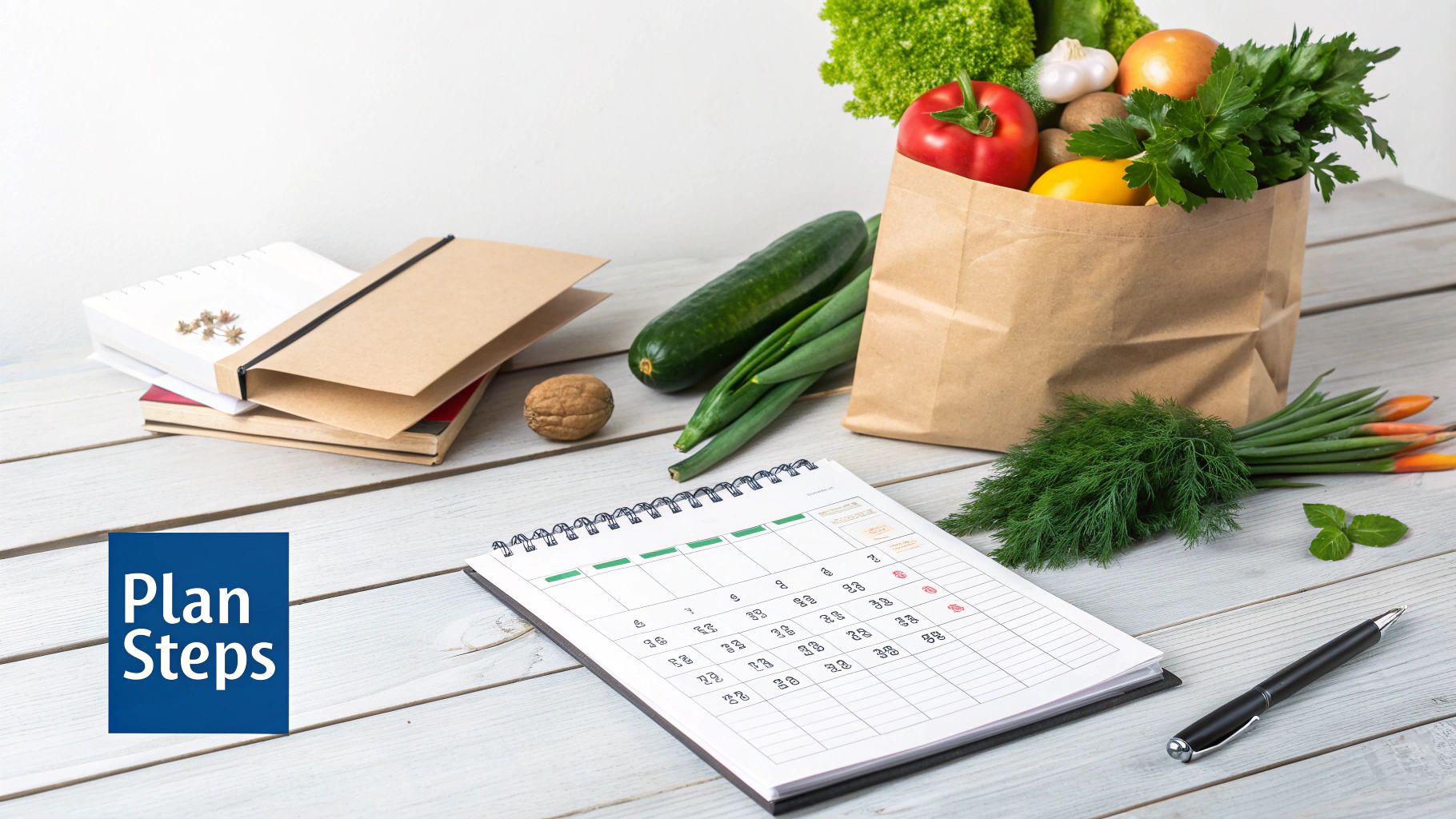
So, you're ready to conquer the kitchen and banish those weeknight dinner dilemmas? Fantastic! This framework will help you build a meal plan that fits your life, your dietary needs, and yes, even your culinary comfort zone. Get ready for less stress and more deliciousness!
Assessing Your Current Eating Habits
First things first, let's take a look at what you're currently eating. Spend a week tracking your meals and snacks. This isn't about judgment, it's about information. Think of it as culinary detective work! Are you a takeout aficionado? A serial snacker? Once you know your habits, you can start making realistic changes.
Consider your dietary needs and preferences, too. Are you a devoted vegetarian? Gluten-free guru? Do certain foods make you feel less than stellar? Knowing this ensures your meal plan is both healthy and enjoyable.
Identifying Realistic Goals
Now that you know your eating habits, let’s set some achievable goals. Start small. Don't try to become a gourmet chef overnight! Maybe plan just two or three dinners a week to start. Baby steps, people!
Once you've nailed those dinners, you can add lunches, breakfasts, and even snacks to your plan. This gradual approach builds confidence and makes healthy eating a sustainable lifestyle, not a fleeting fad.
Choosing Recipes and Building Your Plan
This is where the fun begins! Choose recipes that match your cooking skills and the time you have available. Start with quick, easy recipes and gradually work your way up to more elaborate dishes. Meal Flow AI can offer personalized recipe suggestions if you need some inspiration.
Organize your chosen recipes into a weekly meal plan. Think about your schedule and plan accordingly. Got a late meeting? Choose a super-fast recipe for that night. A little planning prevents those last-minute takeout temptations.
Batch Cooking and Repurposing Ingredients
Want to make cooking even easier? Try batch cooking! Prepare larger portions of ingredients like grains or roasted veggies to save precious time during the week. These prepped ingredients become building blocks for various meals.
Don’t forget about repurposing ingredients to minimize waste. Roast a chicken on Sunday and use the leftovers in salads, sandwiches, or soup later in the week. You'll save money, reduce food waste, and feel good about your sustainable kitchen practices.
Creating a Shopping List and Organizing Your Kitchen
A well-organized shopping list is your meal planning secret weapon. Based on your chosen recipes, create a detailed list of everything you need. Group similar items together (produce, dairy, etc.) to make your grocery shopping trip a breeze.
Organize your kitchen, too. Make sure you have the right storage containers, cooking utensils, and pantry staples on hand. A well-stocked kitchen makes cooking a joy, not a chore.
Building Flexibility into Your Plan
Let’s face it, life rarely goes exactly as planned. That’s why flexibility is key to successful meal planning. Have a few backup meals or adaptable recipes in your back pocket for unexpected schedule changes or surprise guests.
This adaptability keeps your meal plan from becoming a source of stress. It lets you roll with the punches without sacrificing healthy eating habits. Remember, meal planning is meant to simplify your life, not complicate it.
Strategic Shopping: The Meal Planner's Advantage
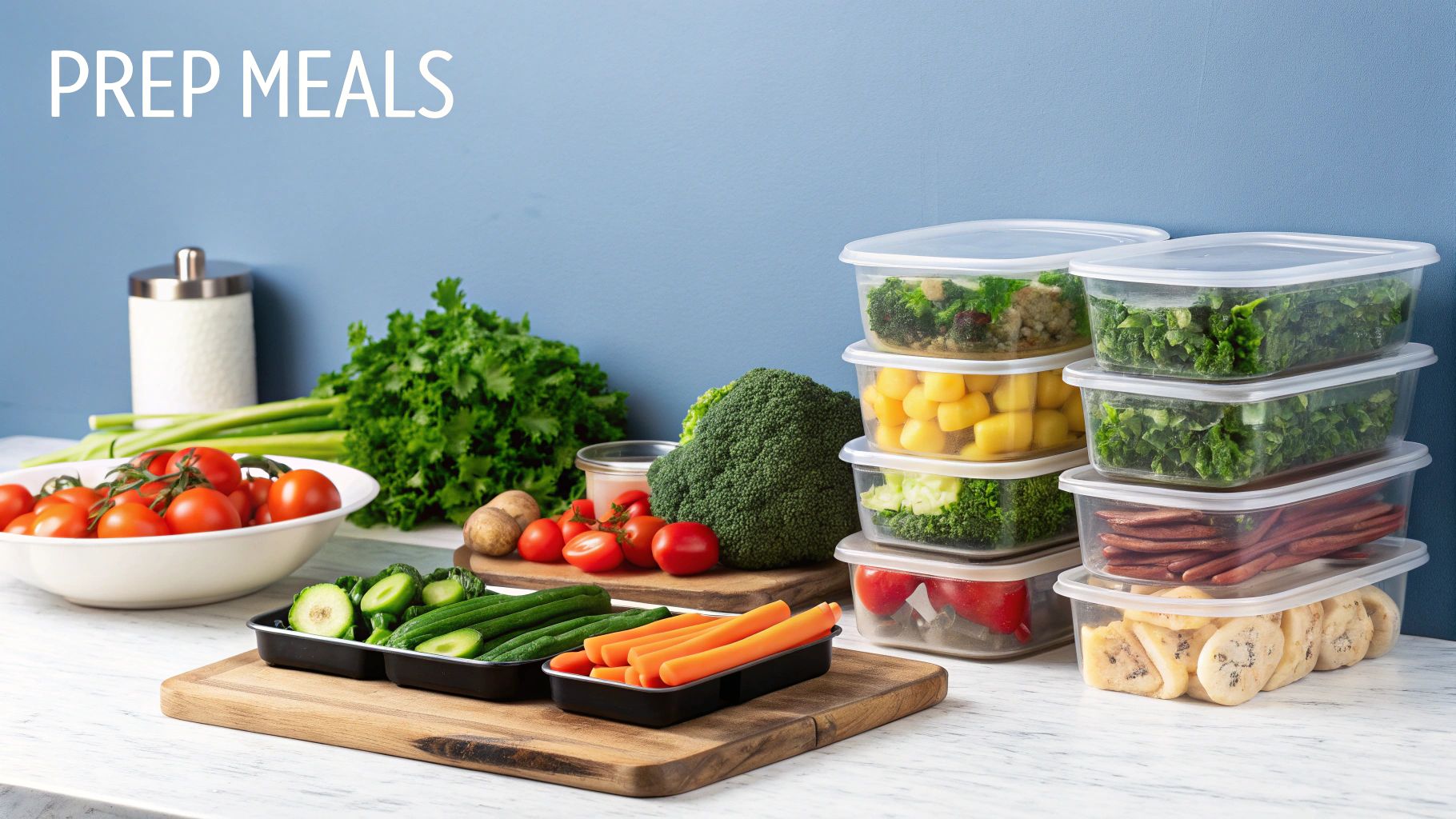
So, you've got your meal plan locked and loaded. Now, let's talk about conquering the grocery store. Strategic shopping is where meal planning truly shines, turning your grocery runs from a chaotic free-for-all into a well-executed plan. This is how you conquer your budget, save precious time, and maybe even stumble upon some exciting new culinary treasures.
Navigating the Grocery Store Like a Pro
Say goodbye to wandering aimlessly. With a well-organized list based on your meal plan, you can navigate the grocery store with the precision of a seasoned shopper. Group similar items together (think produce, dairy, pantry staples) to minimize backtracking and maximize efficiency. This laser-focused approach helps you avoid those tempting impulse buys and keeps your grocery bill under control.
Also, pay attention to your store's layout. Many are designed with fresh, healthy options around the perimeter. Start there to load up on nutritious goodness before venturing into the processed food aisles. It's a smart strategy to prioritize healthy choices.
Decoding Nutrition Labels for Smart Choices
Becoming a label-reading ninja is key to smart meal planning. Zero in on important details like serving size, calories, fat, and added sugars. Seek out foods packed with fiber, protein, and those essential vitamins and minerals. This knowledge empowers you to make informed decisions that fuel your health goals.
For example, compare different yogurts. One might be low in fat but loaded with added sugar. By understanding these nutritional trade-offs, you can choose the option that truly fits your dietary needs.
Seasonal Shopping and Local Sourcing
In-season produce isn’t just bursting with flavor; it's also budget-friendly. Seasonal abundance typically translates to lower prices. Explore local farmers' markets or Community Supported Agriculture (CSA) programs for fresh, top-quality ingredients, often at prices that beat the supermarket.
Connecting with local producers gives you insight into where your food comes from and supports your community. It's a win-win! And speaking of shopping habits, our relationship with food has transformed, especially after the COVID-19 pandemic. The pandemic sparked a boom in meal kit delivery services as people rediscovered the joy of cooking at home. The global meal kit delivery market was worth a whopping $20.54 billion in 2022 and is projected to grow at a 15.3% CAGR from 2023 to 2030. This shift shows a growing desire for convenient and healthier meal options. Learn more here.
Budget-Friendly Strategies for Quality Ingredients
Healthy eating doesn't have to drain your bank account. Savvy meal planners use clever strategies to stretch their food dollars. Buying in bulk for staples like grains, beans, and nuts can save you big. But a word to the wise: only buy in bulk what you'll actually use before it expires. Freezing extra produce or prepped meals is another fantastic way to minimize food waste and save money.
By adopting these practices, you prioritize both nutrition and affordability, creating delicious, healthy meals without breaking the bank. You’ll find meal planning makes grocery shopping far less stressful and expensive than unplanned shopping trips. With a little practice, you’ll become a master shopper, making the most of your food budget and minimizing your time in the grocery store.
Customizing Plans for Your Dietary Reality
Forget generic diet advice! When it comes to meal planning, one size definitely doesn't fit all. What works for your best friend might be a disaster for you, especially if you have allergies, follow a specific diet, or are dealing with picky eaters. So how do you navigate this culinary minefield? Let's dive into personalizing your meal planning approach.
Adapting Meal Planning for Various Dietary Approaches
Whether you're managing a health condition, rocking a vegan lifestyle, or simply aiming for healthier eating, adapting meal planning principles to your unique needs is key. This means understanding the core principles of your chosen diet and finding creative ways to put them into practice.
For example, if you're on a low-carb diet, think zucchini noodles or cauliflower rice instead of pasta. Going vegetarian? Explore plant-based protein powerhouses like lentils, tofu, and tempeh. Adapting your plan keeps it aligned with your goals and, most importantly, enjoyable!
Ingredient Substitution: Maintaining Flavor and Nutrition
The secret sauce to successful dietary customization? Mastering the art of ingredient substitution. How can you make healthy swaps without sacrificing flavor? That's where your inner chef gets to shine.
Let's say a recipe calls for heavy cream. Try swapping it with Greek yogurt or cashew cream for a healthier, lower-fat alternative. This lets you enjoy your favorite dishes while sticking to your dietary guidelines. The world of delicious, healthy eating is your oyster!
Identifying Hidden Nutrition Gaps and Preventing Menu Fatigue
When dealing with dietary restrictions, watch out for potential nutrition gaps. Cutting out entire food groups can lead to deficiencies if you're not careful. How can you make sure you're getting all the essential nutrients? A registered dietitian can be your nutritional superhero.
They can help you pinpoint potential deficiencies and suggest ways to sneak in missing nutrients through other foods or supplements. Plus, mixing up your meals within your dietary restrictions keeps things interesting. Experiment with new recipes and flavors to avoid menu boredom. Technology can also be a game-changer. AI-powered algorithms in apps like Meal Flow AI offer personalized meal plans based on preferences and health conditions. Integration with other health tech makes them super handy for the health-conscious. Explore this topic further. But remember, data privacy is a growing concern, so be mindful of what you share.
Balancing Household Preferences and Creating Meal Rotations
Meal planning gets extra tricky when you're juggling different dietary needs and preferences within the same household. How do you create a meal plan that makes everyone happy?
Communication and compromise are your best friends. Get the family involved in the planning process, letting everyone share their likes and dislikes. A meal rotation incorporating everyone's favorites ensures variety and avoids mealtime drama. Finding common ground makes meal planning more inclusive and enjoyable for the whole family. This is especially helpful when introducing new foods or adapting to recent dietary changes, making the transition smoother for everyone. Ultimately, successful meal planning is about finding a balance that respects everyone's needs and strengthens family bonds.
Troubleshooting Your Meal Planning System
Meal planning. Sounds idyllic, right? Conjuring up images of perfectly portioned meals, stress-free weeknights, and a newfound love for cooking. The reality? Sometimes, it's more like a chaotic juggling act. Life throws curveballs faster than you can say "takeout." But fear not, fellow food enthusiasts! Hitting a few snags doesn't mean you have to wave the white flag and surrender to the siren song of the drive-thru.
Dealing With Unexpected Schedule Disruptions
Picture this: You've crafted the perfect weekly menu, grocery shopping is complete, and you're feeling like a domestic god/goddess. Then BAM! A last-minute work emergency throws your carefully orchestrated plan into disarray. We've all been there. The secret weapon? Flexibility. Having a stash of quick and easy meals up your sleeve can be a lifesaver. Or, embrace the power of technology! Services like Meal Flow AI offer personalized meal planning and even integrate with Instacart for seamless grocery delivery. Talk about a game-changer!
Overcoming Family Resistance
Let's be real, sometimes the toughest critics aren't online reviewers but the people gathered around your dinner table. Introducing a meal plan can be like trying to sneak vegetables into a toddler's mac and cheese – met with suspicion and resistance. The solution? Make it a family affair! Involve everyone in the planning process. Ask for input on meals, consider preferences (within reason, of course – pizza every night isn't exactly balanced). Gradual implementation can also work wonders. Start with planning just a few meals a week and ramp up the frequency as your family adapts.
Managing Motivation Plateaus
We all hit that wall sometimes. The meal planning enthusiasm wanes, the recipe books gather dust, and the allure of convenience food becomes overwhelming. It's perfectly normal! The trick is to reignite that initial spark. Remember why you started meal planning in the first place. Was it to save money? Eat healthier? Reconnect with your "why" to rekindle your commitment. Another tip? Inject some excitement back into your meals! Experiment with new recipes and ingredients. Meal Flow AI and its intelligent personalization features can be a goldmine of fresh ideas tailored to your preferences, combating menu fatigue and keeping things interesting.
Recognizing When Your System Needs Refinement
Sometimes, those meal planning hiccups aren't just temporary setbacks, but signs that your system needs a tune-up. How can you tell? Track your progress. Are you consistently skipping planned meals? Are certain recipes proving too time-consuming? Regularly reviewing your system and making adjustments is key. Think of meal planning as an ongoing experiment. What worked last month might not work this month, and that’s okay. Adapt and conquer! For example, if batch cooking feels overwhelming, try prepping just one or two components of your meals instead. Small changes can make a big difference.
From Project to Habit: Making Meal Planning Stick
So, you've mastered the meal planning basics. Excellent! Now for the real test: turning it into a habit you can actually stick with. We're talking about integrating meal planning so smoothly into your life that it becomes second nature, not just another dreaded chore on your to-do list.
Designing Systems for Reduced Decision Fatigue
One of the biggest perks of meal planning is less decision fatigue. Think about it: with meals planned ahead, you free up precious brainpower for more exciting things. This means building a system that minimizes choices all week long, not just during the initial planning stages. It's like putting your kitchen on autopilot!
For example, theme nights (Taco Tuesdays, anyone?) further streamline decisions, creating automatic choices that eliminate the nightly "what's for dinner?" struggle. This proactive approach transforms meal planning from a weekly project into a daily habit.
Establishing Realistic Review Cycles
Let's be real: no system is perfect, especially when starting something new. Regularly reviewing your plan helps you pinpoint what's working and what needs a little tweaking. This doesn't need to be a complicated affair. A quick weekly check-in can be surprisingly effective.
Start by jotting down which meals were a hit, which ones took too long, and which ingredients ended up in the compost bin. This gives you valuable data to refine your strategy, swapping out recipes or adjusting portion sizes for the next week. Consider it a feedback loop for your culinary adventures.
To help you get started, we've created a handy template:
Weekly Meal Planning Template: A ready-to-use meal planning template with sample meals and preparation tips for beginners.
| Day | Breakfast | Lunch | Dinner | Snacks | Prep Notes |
| Monday | Overnight Oats | Leftover Chicken Salad | Sheet Pan Chicken & Veggies | Apple slices | Chop veggies Sunday night. Make a large batch of chicken on Sunday to use for lunch and dinner. |
| Tuesday | Scrambled Eggs & Toast | Turkey & Avocado Sandwich | Tacos | Grapes | Prepare taco meat Monday night. |
| Wednesday | Yogurt Parfait | Salad with Grilled Salmon | Pasta with Marinara Sauce | Cheese stick | Cook extra salmon for Tuesday’s lunch. |
| Thursday | Smoothie | Leftover Pasta | Pizza | Baby carrots | Use pre-made pizza dough for a quick meal. |
| Friday | French Toast | Leftover Pizza | Burgers | Banana | Prep burger toppings ahead of time. |
| Saturday | Pancakes | Out to eat | Out to eat | Popcorn | |
| Sunday | Waffles | Sandwiches | Roast Chicken & Potatoes | Trail mix | Roast chicken can be used for leftovers during the week. |
This template is just a starting point; feel free to customize it to fit your preferences! Notice how prepping key ingredients on Sunday sets you up for success throughout the week.
Creating Meaningful Accountability
Accountability can be a game-changer for sticking with meal planning. This could be a friend, family member, or even an online community. Sharing your plans and progress can provide a much-needed boost of motivation and support.
Also, consider tracking the tangible benefits of your meal planning journey. This could be documented savings, improved blood sugar control, or even increased energy levels. Creating a personal record of progress reinforces the positive impact of meal planning beyond just convenient meals.
Building a Flexible Practice
Let's face it: life throws curveballs. The key is to build flexibility into your meal planning. Having a few quick, adaptable recipes in your back pocket ensures you can handle unexpected schedule changes without sacrificing healthy eating habits. This allows for spontaneity within a framework of organized planning.
For example, prepped ingredients like roasted vegetables or cooked grains can be used in various dishes, allowing you to improvise based on available time or changing preferences. This adaptable approach makes meal planning a dynamic tool that works with your life, not against it.
Looking for a helping hand? Meal Flow AI creates personalized meal plans and automatically generates Instacart shopping lists. It streamlines the entire process, making meal planning enjoyable, not a chore. Start your free trial today and revolutionize your kitchen routine!